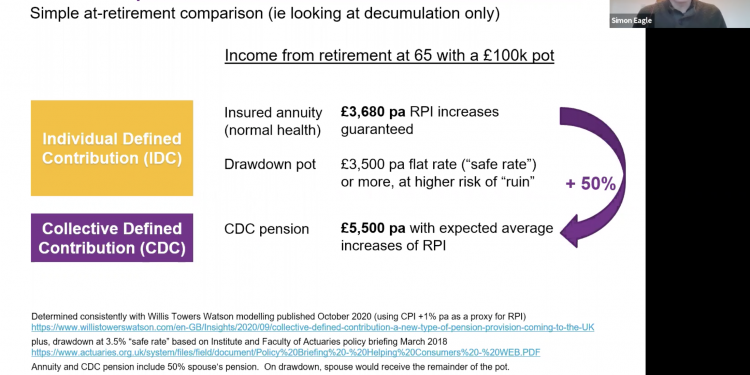An at-retirement collective DC structure could deliver sustainable income 57 per cent higher than can be achieved through income drawdown and 49 per cent more than an annuity, according to figures from Willis Towers Watson.
Speaking at the Corporate Adviser Master Trust and GPP Conference earlier this week, Willis Towers Watson senior director Simon Eagle, who works on its LifeSight master trust, published income comparisons for a DC investor retiring at age 65 with a pot of £100,000 that indicate a retiree could expect £3,680 a year from an RPI-indexed annuity, or make safe returns of £3,500 from an income drawdown pot, but would get a starting income from a CDC decumulation pot of £5,500, expected to also rise with RPI.
The £3,500 figure for drawdown reflects the figure of 3.5 withdrawal set out by the Institute and Faculty of Actuaries recently as a safe rate guide for not running out of money.
The annuity figure quoted is for a healthy retiree.
Willis Towers Watson has been working on the Royal Mail CDC scheme, which new government regulations are expected to permit to operate from late 2021.
Eagle said CDC master trusts could potentially be enabled from 2022 subject to further design work and regulations.
Under the Royal Mail design, benefits are expressed as an amount per year pension, accumulated for each year of employment. Pensions are then adjusted each future year depending on the collective funding level of the scheme, based on actuarial valuations.
Variations in asset returns and member lifespans lead to gradual adjustments to all members’ pension levels. Pensions are expected to increase in most years, but decreases or zero increases are also possible. Schemes need to have at least 5,000 members to be viable said Eagle.
But other forms of CDC could be designed for master trusts or other providers to offer retirees a decumulation-only solution for DC savers looking to use their pots to generate maximum income through their entire retirement.
CDC retirees could expect the uplift in performance because they can invest in higher-return asset classes for longer than individual income drawdown. Also, unlike drawdown investors, the pooled nature of the fund means the retiree does not have to hold back cash to protect them from ‘living too long’. However, no excess funds are left to their estate on death.
Eagle said: “It adopts a relatively aggressive investment strategy compared to DC schemes and most drawdown strategies. It can do that because the members’ pensions are adjusted all the time. Short term volatility doesn’t really matter. What is important is the asset values generated over the longer term.
“Someone with £100,000 at retirement could have three options – an insured annuity, income drawdown or a new option, buying a CDC. They could get £3,680 a year from an RPI-indexed annuity, safely withdraw £3,500 from income drawdown or £5,500 from a CDC pot. If the retiree looks at these three figures the CDC looks pretty compelling.”
Challenged on the point that actuaries had got projections wrong in the past, Eagle said: “If life expectancy increased faster than expected, or if asset returns went even lower than they are already projected to, then yes that would flow through to lower pension, but as an actuary I would say there is an equal likelihood life expectancy may increase less or investment returns could be higher than has been assumed and pension would increase.
“Under the new regime the assumptions are required to be ‘best estimate’ which means a 50 per cent chance of being too high or too low.
“And to counter the challenge that CDC schemes are like with-profits schemes that had problems in the past, CDC schemes will be transparent – they will be required to publish their assumptions as they go along.”





